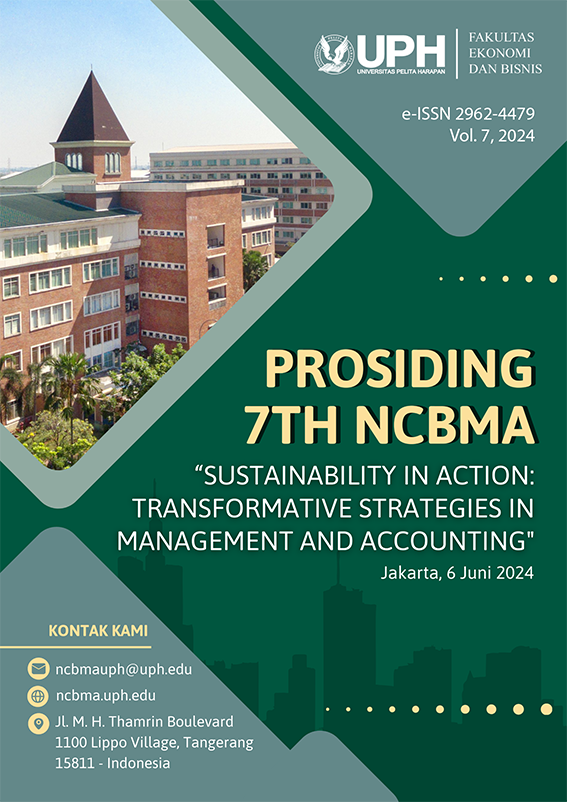UNVEILING THE INVESTORS MIND: AN ANALYSIS OF BEHAVIORAL BIASES IN STOCK INVESTMENTS ACROSS AGE, SEX, INCOME, EXPERIENCE, EDUCATION, AND MARITAL STATUS
Keywords:
Behavioral Biases, Overconfidence, Herding Behavior, Disposition Effect, Sentiment BiasAbstract
This research examines how investor personal characteristics namely age, gender, income, education level, stock investing experience, and marital status are related to investor propensity to experience behavioral biases. Four types of behavioral bias investigated in this research are overconfidence, herding behavior, disposition effect, and sentiment bias. The object of the research is active Indonesian stock investors with minimal 1 year experience. It is found that female investors are more prone to herding behavior compared to male. Longer investing experience is related to lower disposition bias, but higher overconfidence. No other association between other personal characteristics and those four behavioral biases.
References
Adil, M., Singh, Y., & Ansari, M. (2021). How financial literacy moderate the association between behaviour biases and investment decision? Asian Journal of Accounting Research.
Babu, D., & Kurthukoti, D. (2023). IMPACT OF DEMOGRAPHIC VARIABLES ON COGNITIVE BEHAVIORAL BIASES OF AN INVESTORS AND THEIR INVESTMENT DECISIONS. europeanchemicalbulletin.
Bunyamin, M., & Wahab, N. A. (2021). Factors Influencing Financial Risk Tolerance: A Review. International Journal of Industrial Management, 12, 296-305.
Choe, H., & Eom, Y. (2009). The disposition effect and investment performance in the futures market. Journal of Futures Markets, 29, 496-522.
Çömlekçi, İ., & Özer, A. (2018). Behavioral finance models, anomalies, and factors affecting investor psychology. Global Approaches in Financial Economics, Banking, and Finance, 309-330.
Dananjaya, Y. (forthcoming). The impact of behavioral biases to investing performance.
Dhar, R., & Zhu, N. (2006). Up Close and Personal: Investor Sophistication and the Disposition Effect. Manag. Sci., 52, 726-740.
Fisher, P. J., & Yao, R. (2017). Gender differences in financial risk tolerance. Journal of Economic Psychology, 61, 191-202.
Hassan, T., Khalid, W., & Habib, A. (2014). Overconfidence and Loss Aversion in Investment Decisions: A Study of the Impact of Gender and Age in Pakistani Perspective. Research Journal of Finance and Accounting, 5, 148-157.
Jain, J., Walia, N., & Gupta, S. (2019). Evaluation of behavioral biases affecting investment decision making of individual equity investors by fuzzy analytic hierarchy process. Review of Behavioral Finance.
Jensen, M. C. (1978). Some anomalous evidence regarding market efficiency. Journal of Financial Economics, 6(2/3), 95-101.
Lee, K., Miller, S., Velasquez, N., & Wann, C. (2013). The Effect of Investor Bias and Gender on Portfolio Performance and Risk. ERN: Other Microeconomics: Decision-Making under Risk & Uncertainty (Topic).
Mandal, B., & Brady, M. P. (2020). The roles of gender and marital status on risky asset allocation decisions. Journal of Consumer Affairs, 54(1), 177-197.
Malkiel, B. G. (2003). The efficient market hypothesis and its critics. Journal of Economic Perspectives, 17(1), 59-82.
Metawa, N., Hassan, M. K., Metawa, S., & Safa, M. F. (2019). Impact of behavioral factors on investors’ financial decisions: case of the Egyptian stock market. International Journal of Islamic and Middle Eastern Finance and Management, 12(1), 30-55.
Mishra, K., & Metilda, M. (2015). A study on the impact of investment experience, gender, and level of education on overconfidence and self-attribution bias. IIMB Management Review, 27, 228-239.
Mubaraq, M. R., Anshori, M., & Trihatmoko, H. (2021). The influence of financial knowledge and risk tolerance on investment decision making. Jurnal Ekonomi Bisnis Dan Kewirausahaan, 10(2), 140.
Prosad, J. M., Kapoor, S., & Sengupta, J. (2015). Behavioral biases of Indian investors: a survey of Delhi-NCR region. Qualitative Research in Financial Markets, 7(3), 230-263.
Salem, R. (2019). Examining the investment behavior of Arab women in the stock market. Journal of Behavioral and Experimental Finance.
Shukla, A., Rushdi, D. N. J., & Katiyar, D. R. C. (2020). Impact of behavioral biases on investment decisions ”˜a systematic review’. International Journal of Management, 11(4).
Sun, W., Qamruzzaman, M., Rui, W., & Kler, R. (2022). An empirical assessment of financial literacy and behavioral biases on investment decision: Fresh evidence from small investor perception. Frontiers in Psychology.
Verma, N. (2016). Impact of Behavioral Biases in Investment Decision and Strategies. Journal of Management and Research, 3, 28-30.
Downloads
Published
Issue
Section
License
Copyright (c) 2024 Joscelyn Antonius, Yanuar Dananjaya

This work is licensed under a Creative Commons Attribution-ShareAlike 4.0 International License.

